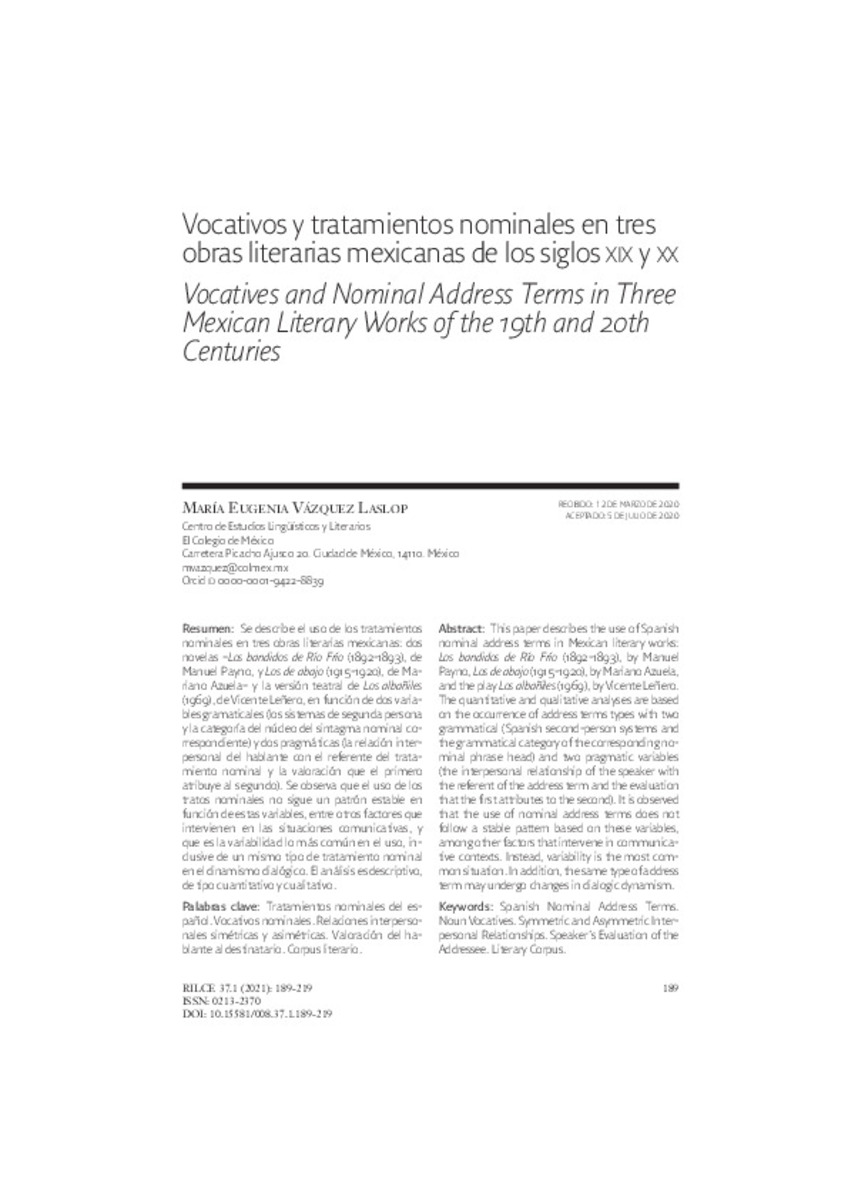Full metadata record
| DC Field | Value | Language |
|---|---|---|
| dc.creator | Vázquez-Laslop, M.E. (María Eugenia) | - |
| dc.date.accessioned | 2020-12-21 | - |
| dc.date.accessioned | 2021-08-30T07:28:16Z | - |
| dc.date.available | 2021-08-30T07:28:16Z | - |
| dc.date.issued | 2020 | - |
| dc.identifier.citation | Vázquez-Laslop, M.E. (María Eugenia). "Vocativos y tratamientos nominales en tres obras literarias mexicanas de los siglos XIX y XX". Rilce: Revista de Filología Hispánica. 37 (1), 2020, 189 - 219 | es |
| dc.identifier.issn | 0213-2370 | - |
| dc.identifier.uri | https://hdl.handle.net/10171/61848 | - |
| dc.description.abstract | This paper describes the use of Spanish nominal address terms in Mexican literary works: <em>Los bandidos de Río Frío </em>(1892-1893), by Manuel Payno, <em>Los de abajo </em>(1915-1920), by Mariano Azuela, and the play <em>Los albañiles </em>(1969), by Vicente Leñero. The quantitative and qualitative analyses are based on the occurrence of address terms types with two grammatical (Spanish second-person systems and the grammatical category of the corresponding nominal phrase head) and two pragmatic variables (the interpersonal relationship of the speaker with the referent of the address term and the evaluation that the first attributes to the second). It is observed that the use of nominal address terms does not follow a stable pattern based on these variables, among other factors that intervene in communicative contexts. Instead, variability is the most common situation. In addition, the same type of address term may undergo changes in dialogic dynamism. | en_US |
| dc.description.abstract | Se describe el uso de los tratamientos nominales en tres obras literarias mexicanas: dos novelas –<em>Los bandidos de Río Frío </em>(1892-1893), de Manuel Payno, y <em>Los de abajo </em>(1915-1920), de Mariano Azuela– y la versión teatral de <em>Los albañiles </em>(1969), de Vicente Leñero, en función de dos variables gramaticales (los sistemas de segunda persona y la categoría del núcleo del sintagma nominal correspondiente) y dos pragmáticas (la relación interpersonal del hablante con el referente del tratamiento nominal y la valoración que el primero atribuye al segundo). Se observa que el uso de los tratos nominales no sigue un patrón estable en función de estas variables, entre otros factores que intervienen en las situaciones comunicativas, y que es la variabilidad lo más común en el uso, inclusive de un mismo tipo de tratamiento nominal en el dinamismo dialógico. El análisis es descriptivo, de tipo cuantitativo y cualitativo. | es_ES |
| dc.language.iso | spa | - |
| dc.publisher | Servicio de Publicaciones de la Universidad de Navarra | es_ES |
| dc.rights | info:eu-repo/semantics/openAccess | es_ES |
| dc.subject | Tratamientos nominales del español | - |
| dc.subject | Vocativos nominales | - |
| dc.subject | Relaciones interpersonales simétricas y asimétricas | - |
| dc.subject | Valoración del hablante al destinatario | - |
| dc.subject | Corpus literario | - |
| dc.title | Vocativos y tratamientos nominales en tres obras literarias mexicanas de los siglos XIX y XX | es_ES |
| dc.title.alternative | Vocatives and Nominal Address Terms in Three Mexican Literary Works of the 19th and 20th Centuries | en_US |
| dc.type | info:eu-repo/semantics/article | es_ES |
| dc.identifier.doi | 10.15581/008.37.1.189-219 | - |
| dadun.citation.endingPage | 219 | - |
| dadun.citation.number | 1 | - |
| dadun.citation.publicationName | Rilce: Revista de Filología Hispánica | - |
| dadun.citation.startingPage | 189 | - |
| dadun.citation.volume | 37 | - |
Files in This Item:
Statistics and impact
Items in Dadun are protected by copyright, with all rights reserved, unless otherwise indicated.






